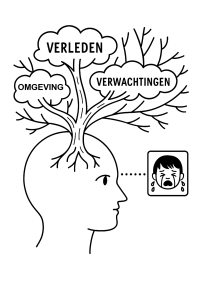How our brains use context
The brain as a prediction machine
Our brains do not passively absorb reality. They actively work as a prediction machine. Every perception is the result of a continuous comparison between:
- the sensory input that comes in
- the expectations our brain has built up beforehand
This principle is described by Karl Friston as the Free Energy Principle (2010): brains constantly try to make the "error" between expectation and reality as small as possible.
The 30/70 rule
Researchers estimate that our experience of reality consists of only a limited part of "raw input." Approximately 30% of what we perceive comes directly from the senses, and 70% is supplemented by our brain through context, memories, and expectations. Context therefore determines the largest part of our experience.
Example: a crying boy

Imagine you see a boy crying. The first, primary reaction is: to comfort him. But context can completely change the interpretation:
- The child cries frequently → you decide not to constantly comfort him, because he needs to learn that falling is not always bad.
- The mother is present → you feel that your intervention is not necessary.
- The child is crying with joy → his team has just won a soccer match.
- The mother is present, but reacts coldly and uninterested → how do you handle this without getting into a conflict yourself?
The same behavior can therefore lead to completely different reactions, depending on the context.
Individual differences in context processing
That context determines interpretation is understood by almost everyone. What is often less recognized: the context sensitivity itself also differs among people.
- The past and experiences of each person are different.
- But in addition, the ability to process context - what I call complex thinking - is also developed differently.
Sommigen zijn er sterk in, anderen hebben meer moeite. Dit maakt dat dezelfde situatie door verschillende mensen heel anders begrepen of aangepakt kan worden.
Selectie en filtering
Context helpt ons ook om niet overspoeld te raken door informatie. Van de duizenden prikkels die per seconde op ons afkomen, bereikt maar een fractie ons bewustzijn. De rest wordt automatisch gefilterd:
- geluiden in de achtergrond verdwijnen naar de marge
- irrelevante visuele details worden onderdrukt
- emotioneel belangrijke signalen worden juist versterkt
Illusies als venster op context
Visuele en cognitieve illusies tonen hoe sterk context ons denken kleurt. Het brein maakt aannames op basis van waarschijnlijkheid, en negeert soms de “ruwe data”. Zo begrijpen we waarom:
- een schaduw een object donkerder of lichter doet lijken
- een onverwachte gebeurtenis (zoals de gorilla in de Monkey Business Illusion) volledig genegeerd kan worden
Van perceptie naar gedrag
De manier waarop onze hersenen context gebruiken, bepaalt niet alleen wat we zien of horen, maar ook hoe we reageren. Als de context ons vertelt dat een geluid gevaarlijk is, zullen we schrikken. Als de context geruststellend is, interpreteren we hetzelfde geluid misschien als onschuldig.
Verder
Zie ook Wat is context? voor een algemene inleiding, en Het spectrum van contextgevoeligheid voor de verschillen tussen individuen.